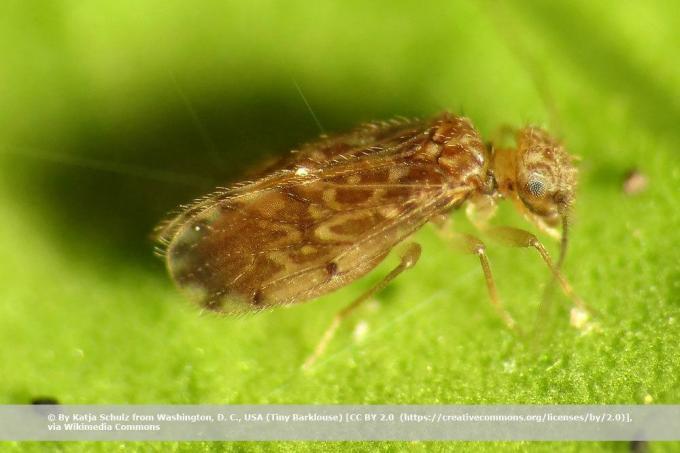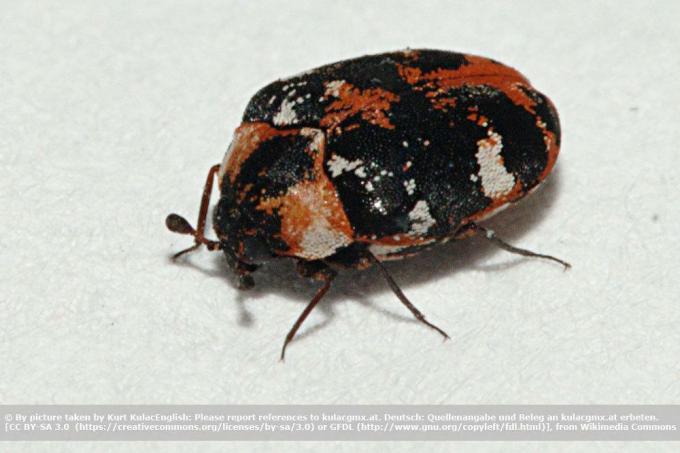
table of contents
- Animal species
- General countermeasures
- Dust lice
- Brass beetle
- Carpet beetle
What a shock! You were just about to take a pleasant bath and suddenly numerous brown bugs are crawling around in the sink, themselves keep reappearing after washing away with the shower or gather in ever larger groups on the wall and there dwell. What kind of animal is it? And the more important question: how do you get rid of them so that you can enjoy your bathroom again.
Animal species
What kind of animals are they?
Silverfish are a classic visitor to the bathroom. However, there are different brown pests that belong to different species and which accordingly have to be handled differently.
- Dust lice (Psocoptera)
- Brass beetle (Niptus hololeucus)
- Carpet beetle (Anthrenus scrophulariae)
Some people assume that the beetle could be bread beetles. These belong in the family of Rodent beetles (Ptinidae) like the brass beetles, but these mostly only attack food and rarely get lost in the bathroom, where there is actually nothing to eat should. The individual animals require different approaches to drive them away effectively, especially in the event of an acute infestation. Since all of the above-mentioned animals can appear without any problems in the event of an infestation, it is important to compare them with one another.

Tip: In case you are not sure which insect it is, you should type the above names into a search engine and look for pictures. Compare these and you will find out in no time what type it is and can then prepare appropriate countermeasures.
General countermeasures
Preparing the bath appropriately can help contain the infestation. Often times, a clean bath is less affected and some of the bugs even warp because they can no longer find food.
Typical actions include the following:
- completely clean bathrooms
- Do not forget any place, for example under or behind the washing machine, on cupboards or behind the boiler
- Here you can check the room for possible mold and damp spots on walls and ceilings
- Disinfect the room, especially tile floors and walls, bathtubs, showers and even air inlets
- ventilate adequately if you have a window in the bathroom
- if you have no windows, leave the door open for a long time or use a dehumidifier
- check the room for possible damage that could allow bugs to get in
- seal them with silicone or filler, as there are often cracks that are used as access

Disinfection
Classic traps are of little help in this case, as they are usually designed for an infestation by silverfish or ants and therefore have no effect on the other animals. Brown animals therefore have to be treated differently, but the previous cleaning and disinfection of the premises offers you a good basis to be able to continue to act. You can also check exactly where the beetles come from, which is particularly important.
Dust lice
What can be done against dust lice?
The dust lice are an order of insects, of which about 100 of the more than 5,600 species occur in Germany.
The characteristics:
- light brown
- Size: 0.7 - 10 mm, depending on the type
- Trivial names: book louse, paper louse
- can jump
- can cause allergies, similar to house dust mites

These beetles need a certain level of humidity and quite high temperatures. For this reason, an infestation of these animals always shows that the humidity in the bathroom is too high. You should therefore ventilate sufficiently and use a dehumidifier as described above if you do not have a window. Just opening the door after bathing or showering is sometimes enough. A possible mold infestation can be related to the animals, as they feed on fungi.
The following measures help against the beetles:
- Bug sprays work extremely well because the lice aren't actually bugs
- Due to their sensitive physique, they absorb the toxins from the spray extremely well
- Openings, crevices and cracks should be treated with the spray
- Dust lice traps can be used very successfully here
- mostly these are traps for silver fish
- put a heater in the bathroom to make the air dry and increase the heat;
- Dust lice don't like the heat at all
- dry your laundry well, as damp textiles are also tempting for the animals
- the beetles can even be picked up with a cloth
The commissioning of an exterminator is only necessary in the case of a very large infestation, which is usually associated with mold or damp walls. Otherwise, with patience, you can fight the dust lice yourself and even successfully.
Brass beetle
What can be done against brass beetles?
Brass beetles are not a welcome evil because they like to get stuck in larger groups and are a curse in old buildings. Half-timbered houses are particularly affected by them, as they only have hollow roofs and false ceilings. The brass beetles can nestle in this and, depending on the access, populate the bathroom or wander into it again and again.
The distinguishing features:
- Color: reddish brown, entire body covered with brass-colored hair
- Size: maximum 5 mm
- Physique resembles that of a spider, clearly separated segments
- has wings
- are not carriers of disease
- do not cause allergic reactions
- keep away from people

Brass beetles are considered building pests because they eat up numerous materials in the house, including insulation materials and textiles. Dirty and damp laundry in particular exerts a great attraction on them. Damp rooms are often used as living space because they prefer moisture. In and of itself, there is not much you can do against brass beetles and you will need to contact a professional. However, you can dehumidify and clean the bathroom as described above, and you should also wash infected laundry at 60 ° C and hang it up outdoors or dry it in the machine. Don't wait to fight it, it could be expensive.
Carpet beetle
What can be done against carpet beetles?
The carpet beetle is also a small, brown pest that mainly focuses on textiles, as the name suggests.
The characteristics:
- Color: black, gray, brown, patterned
- Size: 3 - 4.5 mm
- Body shape: oval, reminiscent of the head of a pin
- Arrow hairs of the larvae can lead to symptoms of poisoning in allergy sufferers
- Larvae: brown-reddish, elongated shape, shy of light

Carpet beetles cause high material damage and feed mainly on chitin and substances containing keratin, including hair, skin and numerous other materials such as natural fibers and even paper. You can find them in dirty laundry and less in damp places in the bathroom. The beetle even nests in rubbish bins or the sink in the bathroom as soon as hair, fingernails and toenails as well as flakes of skin are found here.
Proceed as follows here:
- look for the source of the carpet beetle
- Vacuum contaminated textiles, brush them off and clean at 60 °
- Vacuum all cracks, corners, crevices, just everything where brown bugs might be
- then apply diatomaceous earth to these areas; this works effectively against the animals
- Then seal these areas, including loose wallpaper ends
- Fly screens are generally a noteworthy recommendation so that the animals do not get into the living space
- You should remove old bird nests near the house, as the beetles like to nest there
- set up a carpet beetle trap in the bathroom near the spring
- this works on the basis of pheromones and works effectively against the animals
- through this the infestation is contained, but not completely stopped



